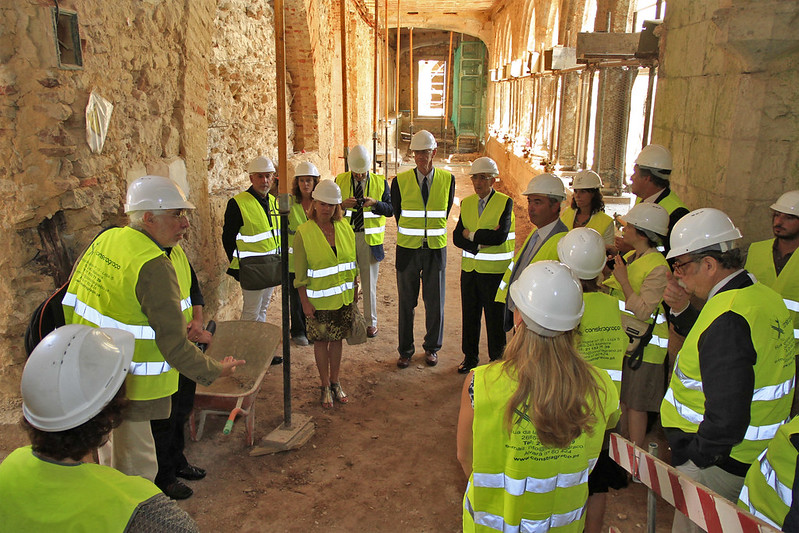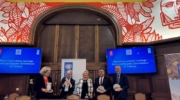The 7 Most Endangered: first rescue mission takes place in Setubal, Portugal
A top-level delegation of heritage and financial experts from Europa Nostra and the European Investment Bank Institute visited the monastery of Setúbal, one of The 7 Most Endangered Monuments and Sites in Europe, and took part in several working meetings with local and national entities on 4-5 September. The 15th century monastery was in such an advanced state of decay that the municipality of Setubal decided to go ahead with emergency rehabilitation works at the end of 2012. However, national and European technical and financial support is needed to implement the fourteen-million-euro restoration and modernisation project, which will fully return this masterpiece to its former splendour and act as a catalyst for the social and economic revitalisation of the city centre.
The monastery of Jesus in Setúbal is one of the first examples of the Portuguese Late Gothic style, known as Manueline, which skillfully incorporates maritime elements and representations from the pioneering voyages of the Portuguese explorers. It has been listed as a National Monument since 1910. Recognised as a tangible witness of Europe’s shared history – having served as the setting for the ratification of the signature of the Treaty of Tordesillas in 1494 between Spain and Portugal which paved the way for Europe’s expansion both to the Americas and to the Far East – it was conferred the European Heritage Label by the European Commission in 2011. Despite its rare historic and heritage value, the monument has been generally closed to the public for more than 20 years, due to lack of funds from the owner, the Portuguese State, to cover the extensive and costly conservation project.
Given the advanced state of disrepair of the building, the financial incapacity assumed by the State through the Regional Directorate for Culture and the need to secure European Union funds, obtained through the National Strategic Reference Framework (NSRF 2007-2013), the municipality of Setúbal initiated the most urgent reconstruction works at the end of 2012, after signing an agreement of cession of use and management of the building. The first phase of the project fundamentally consists of the structural rehabilitation of the monastery, and the total recovery of the western wing, which will receive part of the collection of the city’s museum. This first intervention, budgeted at 3.2 million euros (65% of which funded by the NSRF and 35% by the municipality of Setubal), is a major step forward in rescuing the monument. However, its complete restoration is still far from guaranteed. Around 14 million euros are needed to fully restore and modernise this gem of Europe’s heritage.
The main goal of Europa Nostra and EIB Institute’s mission was precisely “to make a technical analysis of the second phase of the project and thus improve the chances of funding, mainly through the next NSRF (2014-2020), which could take an important part of this work”, stated Guy Clausse, Director and Special Advisor of the European Investment Bank. “It is a very ambitious project with good foundations. It will require a significant investment and therefore several funding sources”, he added. The global project includes the complete rehabilitation of the monument, which will accommodate the entire collection of the local museum, and the construction of a new building, which will house temporary exhibitions, an auditorium, a documentation centre/library and educational, administrative and storage areas.
On 4 September, after the welcome reception by the Mayor of Setubal, Maria das Dores Meira, and the President of the Portuguese Historical Houses Association, Hugo O’Neill, who made the nomination for ‘The 7 Most Endangered’ programme, the delegation of Europa Nostra, represented by its Council Member José-Maria Ballester and its Scientific Council Member Pedro Ponce de Léon, and the EIB Institute, represented by Guy Clausse and Peter Bond, attended a lecture about the heritage and historical importance of the monastery, delivered by professor Baptista Pereira, and a presentation about the revitalisation project, given by the architect Carrilho da Graça. The working visit to the monument was followed by a technical and financial meeting. Representatives of the Secretariat for Culture and the Centro Nacional de Cultura, Europa Nostra’s representation in Portugal, also attended the gatherings.
On 5 September, the European delegation, together with the team from the municipality headed by its Mayor, gathered with the Secretary of State for Culture, Jorge Barreto Xavier, in Lisbon. The discussion of financing models and the participation of the Portuguese State in the financial plan for the global rehabilitation of the monastery dominated the agenda. “It is extremely important to garner national support so that the monument doesn’t miss this opportunity to be recovered without burdening the State finances”, stressed the Mayor of Setúbal. The Secretary of State for Culture promised to give the deserved attention to the case and collaborate both with local and European entities.
The results of the rescue mission to Setubal will be presented, together with the outcomes of the other six missions, at the European Heritage Policy Conference, organised by Europa Nostra, in Brussels on 5 December.







